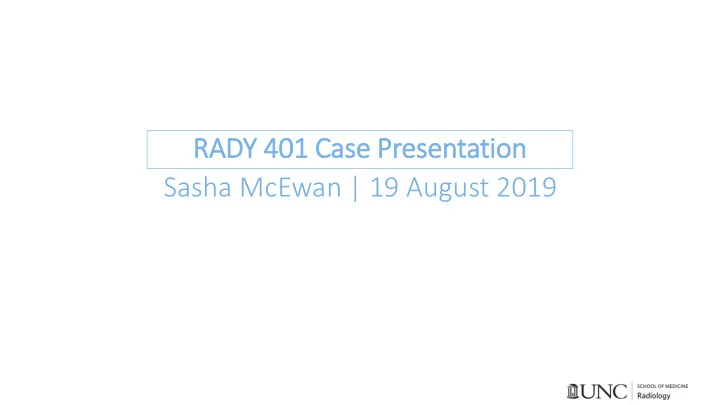

RADY 401 Case Presentation Sasha McEwan | 19 August 2019
In Initial patient his istory ry and workup • Jane Doe is a 38-year-old female with no significant PMH who initially presented to the emergency department with abdominal pain and mild leukocytosis, discharged without imaging or intervention. • Re-presented five days later with right lower quadrant abdominal pain • Vitals: T 97.9 F | BP 100/62 | HR 83 • Physical exam • Abdomen soft, RLQ tenderness just above McBurney point. Guarding and rebound tenderness present. • Lab data • WBC 13.1 • Beta HCG negative
Im Imaging stu tudies obtained • CT Abdomen/Pelvis with IV Contrast
Im Imaging stu tudies obtained CT Abdomen/Pelvis with IV contrast, axial planes GI Tract Findings: Edematous and dilated appendix with luminal discontinuity at the tip and adjacent free air.
Re Re-presentation to ED following appendectomy • Initial outcome: Patient underwent laparoscopic converted to open appendectomy secondary to significant inflammation. Completed four days of Zosyn and was not reimaged prior to discharge 8 days later • Four days after discharge, returned to emergency department with 2 days of lower abdominal pain and pressure and subjective fever • Afebrile, BP 95/61 • WBC 17.5 • Physical exam: mildly tender to palpation in bilateral lower abdominal quadrants, incisions clean, dry and intact with no swelling or erythema
Imaging stu Im tudies obtained CT Abdomen/Pelvis wit ith IV IV contrast, , axia ial pla planes Findings: Sequelae of recent appendectomy with phlegmonous changes along the mesentery of the mid-pelvis with mild peripheral enhancement, mesenteric stranding and free fluid along the site of the appendectomy with tiny locules of extraluminal gas.
Im Imaging stu tudies obtained CT Abdomen/Pelvis wit ith IV IV contrast, , cor oronal l pla plane Findings: Sequelae of recent appendectomy with phlegmonous changes along the mesentery of the mid-pelvis with mild peripheral enhancement, mesenteric stranding and free fluid along the site of the appendectomy with tiny locules of extraluminal gas.
Sm Small bowel in inter-loop abscess – Patient course • Readmitted to SRH and started on Zosyn • VIR consult – no safe window for aspiration of ill-defined abdominal fluid collection, consider repeat imaging and consultation if patient acutely worsened • Discharged on hospital day 4 with improved symptoms and leukocytosis with a one-week course of Augmentin • Readmitted two weeks later with same symptoms and leukocytosis to 18.5
Im Imaging stu tudies obtained Prio rior CT New CT Interloop abscess measures 3.8 x 4.0 x 5.5 cm (previously approximately 3.2 x 2.4 x 4.8 cm) CT Abdomen/Pelvis wit ith IV IV contrast, , axia ial pla planes Impression: Interval increase in size of the known interloop abscess adjacent to the postappendectomy surgical line with associated mesenteric stranding and peritoneal thickening and enhancement; mildly increased free fluid within the pelvis.
Im Imaging stu tudies obtained Prio rior CT New CT Interloop abscess measures 3.8 x 4.0 x 5.5 cm (previously approximately 3.2 x 2.4 x 4.8 cm) CT Abdomen/Pelvis wit ith IV IV contrast, , cor oronal l pla planes Impression: Interval increase in size of the known interloop abscess adjacent to the postappendectomy surgical line with associated mesenteric stranding and peritoneal thickening and enhancement; mildly increased free fluid within the pelvis.
Follow up Outcome • Discharged on 2 weeks of Flagyl and Augmentin. • Plan for 2 week follow up imaging in clinic to determine definitive treatment. • Two week CT: Interval decrease in size of known interloop abscess, now measuring a maximum dimension of 3 cm, with surrounding mesenteric stranding.
Abdominal abscess • ACR: CT Abdomen/Pelvis with IV contrast usually appropriate for acute, nonlocalized abdominal pain • Generally avoided in post-operative patients as fluid collections are often present but not infected and may lead to unnecessary treatment • Ultrasound • Fast, avoids ionizing radiation, good for evaluation of more complex collections • Limited use for deeper soft tissue infections or for collections adjacent to bowel • Used to screen for superficial fluid collections or for collections adjacent to solid organs • CT • Usually first-line modality in patients with fever of unknown origin • Used to detect deeper collections with IV and/or oral contrast to help distinguish from adjacent bowel or vasculature - CT: 300 300 to o 5000 5000 dolla dollars, ult ultrasound clo closer to o 250 250 - Rad adiation: CT 5-10 10 msV sV, , ult ultrasound non none - No o exact sen sensit itivity and and spe specificity rep reported du due to o such such a a var varie ied pre presentation
findings 3 Abdominal abscess: ty typical CT CT fi • Will typically have a low-attenuation central necrotic component • Well-defined capsule that may be thicker and more irregular than a typical cystic wall • Capsular ring enhancement with contrast • Surrounding peritoneal fat stranding • Mass effect with adjacent structures
Treatment options • Varies based on patient status and body habitus, institution, size and location of the collection, etc. • Antibiotics and supportive treatment +/- needle aspiration of fluid collection for drainage or to narrow antibiotic regimen • Percutaneous drainage • Usual treatment for large (>4-5 cm) collections, if possible • Endoscopic drainage • Immediate or delayed surgery
Take-home points • Routine imaging of post-operative patients is not encouraged • Ultrasound is fast and does not utilize ionizing radiation; however, it is not useful for deep infections or collections adjacent to loops of bowel and CT should be used for these cases • Abscesses can be extremely difficult to resolve and options for treatment include IR-guided percutaneous drainage, surgery, and antibiotics
References 1. ACR Appropriateness Criteria – Acute Nonlocalized Abdominal Pain. Available at acsearch.acr.org/docs/69467/Narrative. American College of Radiology. Accessed 19 August 2019. 2. ACR Appropriateness Criteria - Radiologic Management of Infected Fluid Collections. Available at acsearch.acr.org/docs/69345/Narrative. American College of Radiology. Accessed 19 August 2019. 3. Bell, Daniel J. and Frank Galliard, et al. “Abscess.” Radiopaedia. Available at radiopaedia.org/articles/abscess?lang=us. Accessed 19 August 2019.
Recommend
More recommend